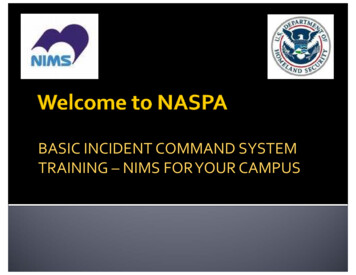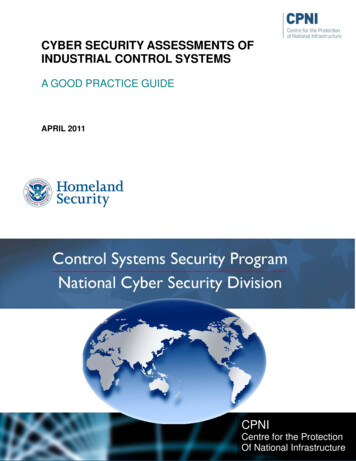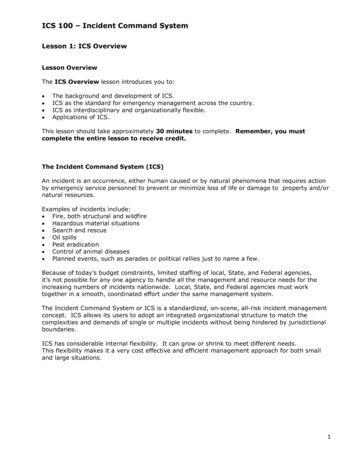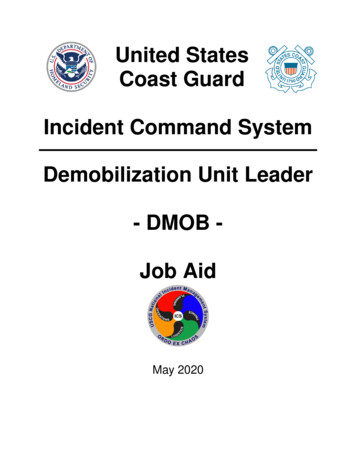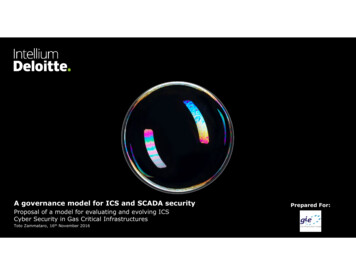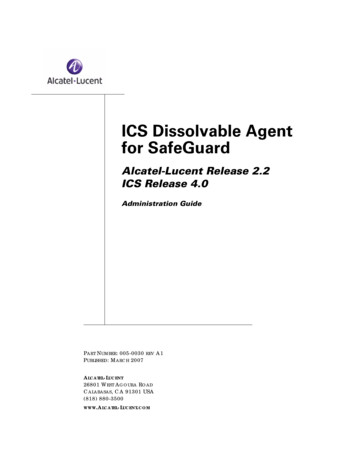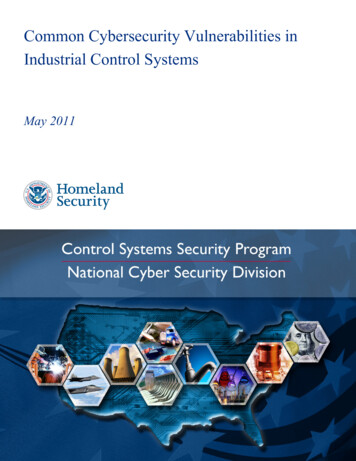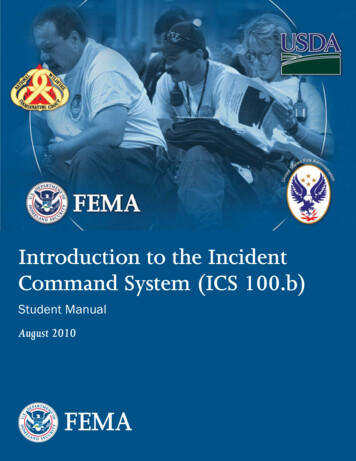
Transcription
Secondary Story HeadlineCURRICULUM GUIDE2020INTERNATIONALCOMMUNITY SCHOOLMARGARET KINNEY, PRINCIPALLAKE WASHINGTONSCHOOL DISTRICTDR. JON HOLMEN, SUPERINTENDENT
CURRICULUM GUIDE 2020-2021The Academic ProgramThe academic program at ICS is a challenging seven year courseof studies in six academic areas:The Arts, Humanities, International Studies, Mathematics,Science and World Language.Our fundamental concepts include: Small student population (approximately 450 students,Grades 6—12) with a community atmosphere Close, long-term relationships between students andteachers An emphasis on depth of understanding rather thanbreadth of offerings Rigorous curriculum that emphasizes interconnectedlearning and skill development organized around essentialthemes Opportunities for foreign exchange and travel Promotion to more advanced levels tied to performanceand mastery Arts emphasized as a full partner in the curriculumAn expectation that students will set their own highstandards and meet them.ArtThe Arts are a universal language that weuse to make sense of our world. The studyof the Arts requires a sequential processthat builds on prior learning. Art Education is a combination of concepts, skills,techniques and processes. The ICS ArtsProgram is grounded in the Visual Artsincluding Art History and explores theother Arts disciplines of Music, Dance, andTheatre.At ICS the Arts integrate with the block(Arts, International Studies and Humanities) strengthening the core content connections as well as focusing on the essential understandings and critical contentfrom the Lake Washington School DistrictFrameworks and OSPI Learning Standardsfor the Arts.control as a measure ofsuccess in the program.Level 0 ArtIntroduction to the Foundations of theCriticism, Aesthetics, and Art Production.ArtsThis year focuses on the Elements of Art(color, form, line, shape, space, texture, andThis is our foundation course for stuvalue), and introduces the Principles of Dedents to explore the discipline of thesign (balance, contrast, emphasis, movement,Arts which includes: Art History, Artpattern, rhythm, and unity), as well as introducing the standards related to the other artsdisciplines of Dance, Media, Music, and Theatre. Students will also explore the creativeprocess and establish cooperative studioskills.Integration: Subject Specific FoundationalKnowledge, Museum StudiesOur goal is to create life long learners inthe Arts. Each level integrates essentialunderstandings from the block combinedwith developing Arts concepts. ICS Artsstudents practice key cognitive strategiesthrough problem solving, analysis andinquisitiveness, to achieve understandingof themselves as instruments of communication and expression.Level 1 Art: Prehistoric Arts and the Artsof Early CivilizationsPrerequisite: Introduction to the Foundations of the Arts or Equivalent (PlacementExam)This year focuses on the Principles of Design(balance, contrast, emphasis, movement,Studio based classes in the Arts at ICSreinforce academic behaviors such as selfawareness, self-monitoring and self-3
International Community Schoolpattern, rhythm, and unity) as they relate tothe Elements of Art (color, form, line,shape, space, texture, and value), applyingthem to larger and more complex problems that involve a larger variety of mediums, focusing on skills and techniques.This level begins to expand our students’understanding of culture, asking the essential question: How do the arts shapeand reflect culture and history?HumanitiesIntegration: Prehistoric Art, Ancient Cultures, Northwest CoastLevel 2: Topics in Non-Western ArtsPrerequisite: Level 1This level incorporates a study of multiplecultures around the world, studying artshistory, cultural traditions, and a variety oftraditional media. Visual skills continue tobe developed, purposely building uponprevious skills to stretch and reinforce 3dimensional visual cognition. NationalHistory Day is supported through an introduction to graphic design and presentationskills.Integration: NHD, South America, Mesoamerica, Africa, India, EgyptLevel 3 Honors ArtArt’s Roots in the Ancient WorldPrerequisite: Level 2The focus of Level 3 is on the study of thebeginning of Western Arts as seen in theArts and Architecture of Classical Greece,Rome, and Byzantine eras. Studio projectsare directly related to this historical study;bringing forth prior learning while at thesame time allowing students to continuedeveloping an artistic voice.Integration: Greek, Roman, and ByzantineLevel 4 Honors ArtMiddle Ages through Baroque ArtsPrerequisite: Level 3Students in Honors Level 4 study the Artand Architecture of the Middle Ages, Renaissance, and Baroque periods. They continue to explore the Arts as a visual language by expanding their observationalskills and delving into complex media, techniques and skills in 2-D and 3-D includingsymbolism and nonrepresentational art.Integration: Middle Ages, Renaissance, andBaroqueLevel 5 Honors ArtArt in AmericaPrerequisite: Level 4Honors Level 5 looks at the Arts and thecorresponding international influences thathave shaped American society from Neoclassicism to Contemporary Art. Studioprojects are directly tied to historical studies to allow students to delve deeper intomore complex problem solving opportunities.Integration: United States and World HistoryLevel 6 Honors ArtContemporary Issues in ArtPrerequisite: Level 5 or currently in level 5tive professionals. In addition, this classwith address fundamental business concepts, professional practices, and marketingcommunications, as well as a basic understanding of consumer behavior.Leadership component: National Art HonorSociety.This course meets Career and Technical Education/Occupational Education graduationrequirementsAP Studio Art (Bi-Annually)Prerequisites: Successful completion of Level 5, or currently taking Level 5This course follows the requirements setforth by the College Board to certify an APThis course is designed to be the culmicourse in Studio Art in Drawing or Design.nation and application of the art skills, tech- Students will produce a volume of qualitynique and knowledge developed over thepieces of art, addressing the 3 sections of anprevious five years at ICS. This will be aAP portfolio: Breadth, Concentration, andplace where the student’s individual artistic Quality. Students will be challenged to devoice can be further encouraged and devel- velop and execute their own ideas andoped. The focus will be on portfolio develthemes. Student will be required to use aopment, current trends and issues in thevariety of mediums, techniques, and aparts, career exploration, and extending our proaches.journey into larger more complex problemsolving opportunities within the arts. Students will also have the chance to take their Humanitiesarts into the community in some way.Introduction to HumanitiesLevel 6 Art: Graphic Production—CTE(Bi-Annually)Prerequisite: Successful completion of Level5, or currently taking Level 5Prerequisite: NoneThe discipline of humanities combines written composition, literature study and philosophy. In the introductory course, studentsStudents will gain a deep understanding learn the elements of basic composition byof the advertising industry and the business learning parts of speech, verb forms andtenses, and patterns of phrases and clauses.of art. Through lectures, readings, handson assignments, guest speakers, and fieldThese elements are practiced through writtrips they will be introduced to the roles of ing exercises in several genres: memoir,advertisers, advertising agencies and crea- short story, poetry, song and drama. The4
CURRICULUM GUIDE 2020-2021course also focuses on the primary modesof storytelling: pictorial, oral, and written.Students are introduced to basic literaryanalysis, including the elements of shortfiction: plot, setting, character, and conflict.Level 1 HumanitiesFoundations of Literature AnalysisPrerequisite: NoneLevel 1 combines English language andcomposition study with a thematic approach to literature. Students begin byreviewing parts of speech, verb forms andtenses, and patterns of phrases. The language study continues with an in-depthstudy of clauses and types of sentences.Students progress to descriptive and literary analysis paragraph writing with a focus on clear topic sentences, organization,specific details, varied sentence structure,and strong word choice. Continuing paragraph writing, students explore the effectsof the Neolithic Revolution. The ontogenetic metaphor as well as the monomyth(a pattern of loss, journey, test and return/resolution) are introduced. Various ancient myths including Osiris, Orpheus, andPersephone are compared with modernshort stories and longer works such as TheGiver and Anthem.Integration: Foundations and patterns in history, art, and literatureLevel 2 HumanitiesLimits, Freedom, Society & the IndividualPrerequisite: Level 1The overarching theme for this year is therelationship between society and the individual and the impact that relationship hason the human condition. Students examine how tension and cooperation betweenthe individual and societyfunction in classic and contemporary world literature. Reading some contemporary stories (such as JackLondon’s “To Build a Fire”and Shirley Jackson’s “TheLottery”) and some ancientChinese philosophy(Confucius, Xunzi), studentsdiscuss broader questions oftruth while also exploringlimits as metaphors and therole of traditions in society.Students also read and discuss various works that reflect the theme ofthe consequences for individuals who attempt to literally or metaphorically returnto the past. We explored this theme in Level1 with Inherit the Wind; this year the returnto the past theme will be examined throughShakespeare’s Julius Caesar and the filmPleasantville. Next, students analyze different society’s ideas of heroism and womanhood (Sinbad stories from Arabian Nights,The Ramayana, and Maxine Hong Kingston’sThe Woman Warrior). We will also look at aseries of dystopian stories which highlightthe conflict between the individual and society (Ray Bradbury’s Fahrenheit 451 andMarjane Satrapi’s Persepolis). These issueswill be explored through journal writing,class discussion, creative projects, literatureanalysis, and analytic writing.Level 3 Honors HumanitiesFoundations of the Western World: Metaphysics and the HeroPrerequisite: Level 2In Level 3, students begin by examining Greekmythology and The Odyssey followed by astudy of the metaphysics of the pre-Socratics,Socrates, and Plato. Materialists and Idealistsare contrasted, and their ideas are applied toclassical and world literature. Students explorethe metaphysical perspectives of various classical and contemporary poems.Students study the hero cycleand study how the Book of Joband J.B. follow the quest pattern. All of these issues, aswell as work-specific themesand symbolism, are exploredthrough discussion, debate,and analytic writing. Studentsdemonstrate writing skillsthrough paragraph and essaycomposition and continuework on performance.5Level 4 Honors HumanitiesWorld LiteraturePrerequisite: Level 3This course takes a chronological approachto the study of world literature and buildsupon the thematic, philosophical and religious studies of previous levels. Studentsbegin with medieval European literature,analyzing the epic poem Beowulf and Dante'sInferno. Next, they move through the Enlightenment with a study of Jonathan Swift's satirical essay A Modest Proposal and then examinea major literary movement that grew as aresponse to the Enlightenment: Romanticism. Students approach the Romantic movement through analysis of key British poets,including Blake, Wordsworth, Coleridge,Keats, and Shelley. They also read MaryShelley's Frankenstein, a novel inspiredby Romantic movement themes. Issues related to colonialism and the impact of colonialism are explored by reading Things Fall Apartby Nigerian novelist Chinua Achebe and Inthe Time of the Butterflies, a historical novel byJulia Alvarez set in the Dominican Republican. Connecting to themes presented in levels2 and 3 and earlier in the year, One Flew Overthe Cuckoo's Nest will also be studied. Buildingupon the writing foundations established inprevious years, students will also continue toimprove upon essay, creative and timed writing.Level 5 Honors HumanitiesAmerican LiteraturePrerequisite: Level 4This course continues in-depth literaturestudy with an emphasis on increasing selfdirection. Focusing on canonical and noncanonical works, students make thematiccomparisons between essays, poems, shortstories, and novels. Themes include the mythof the West, patriotism, the heroic quest, the
International Community SchoolFilm StudiesThis course introduces students to theelements, history, and genres offilmmaking. We begin with the elements offilm and study varying techniques andstyles of narrative, cinematography,editing, sound, acting, and we will discusshow these elements add to the meaning(s)of a film. In the second semester, we moveto cover a basic history of film--from earlysilent films to the Golden Age of Hollywoodto the present day while also introducingand providing historical context and genreconventions for several film types includingthe documentary, the western, film noir,and romantic comedy. Class time will bespent watching film clips and several fulllength films and discussing the readingsand films watched in class. Class time willalso be given to complete the readings andwork on papers and projects.This class satisfies the Occupational Education graduation requirement.International Studies (IS)The International Studies department atICS is a rigorous seven-year inquiry-basedprogram designed to create global citizenswho are able to interpret historical eventsto better understand our current world.The IS department is focused on the socialsciences including anthropology, psychology, sociology, economics, and political science. We are dedicated to viewing allevents through a larger international lensas opposed to focusing solely on an American interpretation.Throughout their seven years, studentswill focus on a litany of skills to aid them inbecoming informed global citizens. The ISdepartment puts a significant annual focuson long-term academic research. In orderto accomplish this, students are preparedto understand primary, secondary, andtertiary sources, how to interpret information from various forms of media, bestpractices for presenting information, andproper methods of citation (MLA 8).mental concepts and trends of History andGeography. On a very basic level, studentsstart with the major themes of Geographyto look at the earth and its features. Students analyze how humans work to controltheir surroundings, the role geographyplays in historical events and human interaction, and the definitions of location, region, place and movement. A look at theuses of maps to identify earth’s physicalfeatures, shifting political boundaries, andthe patterns and distribution of humanbehavior combine to reveal how humansoccupy the earth. The students will differentiate between physical systems and human systems, and investigate on an introductory level the value of culture interaction, forms of government, disciplines ofeconomics, and the impact of science andtechnology on societies. They study howmaterials and components that are foundwithin the environment are extracted, depleted, protected and managed. The semester culminates with an in depth look atglobalization and how it affects the world,the United States, and their own lives.In the second semester, students focuson human migration and immigration, withdirect attention payed to immigration tothe United States. Specific areas of studyinclude push/pull factors, Angel and EllisIslands, immigration laws in US history,and the appropriate use of primary andsecondary sources. In the 3rd quarter, Chinese immigration to the United States inthe 1800s is used as a case study to provide the students with the depth and understandingthey willneed tostudy othercases of immigration.Using thisexamplecase, thestudents willcomplete anLevel 0 Introduction to ISStudents are introduced to International Studies by investigating the funda-6"immigration museum" project about othermigrating groups. This introduces the level 0 students to a long-term research project, which they will complete in their International Studies courses every year.Level 1 ISLevel 1 International Studies begins with asemester long, in-depth look into Washington State's history. Students investigatequestions that aim to seek a better understanding of Washington State as a microcosm of man’s development, and how it'shistory reflects and mirrors the development of humans elsewhere in the U.S. andthe world. Students will expand on theirlearning of geography from Level 0, specifically as it relates to the development ofearly and subsequent populations in Washington State. Additionally, students will beintroduced to the first peoples of Washington State, how has Washington Stateshaped and been shaped by world events,and the structure and strengths of Washington State’s government systems andeconomy. Throughout the entire first semester students will examine the significant events, governmental systems, andcultural trends that characterize the growththat Washington State contributed to thepolitical and economic entity it is now.Washington State History wraps up with aCivic Tour field trip to the State's Capitol inOlympia, Washington.This course meets the graduation requirement for Washington State History.
CURRICULUM GUIDE 2020-2021Second semester Level 1 InternationalStudies explores how the evolution of earlyman became significant once humanslearned to control nature and exploitearth’s resources. Students study how theworld began according to creation mythsand current scientific theories. Why andhow did the first humans try to control nature? What are the major factors that makeup a “civilization”? What parts do religionand nature play in social development?How did early humans populate what isnow Europe, Asia, and the Americas? Taken together, these questions follow the in-creasing sophistication of humanity’s cognitive development, technology, government, and religious institutions. Studentswill formalize the inquiry-based learningtechniques that they were introduced to inLevel 0 IS. In addition, students will conduct a long-term research project focusingon human-environment interactions; thisacts, in part, as an introduction to the typeof research students will be engaging inwith National History Day (NHD) in Levels2-4 International Studies.Level 2 ISPrerequisite: Level 1Level 2 International Studies is a year ofexploration of civilization. Student will getthe opportunity to dive in-depth into several first empire and ancient civilizations.Students begin the year examining the history and culture of the Kingdom of Aksum,then take flight to Ancient China, whereriver dynasties rule. After that, they studythe ancient civilizations of Mesoamericaand the Andes; they learn that harsh climate and adversity cannot stop a society’sdevelopment. They end first semester witha comprehensive look at the agricultureand religion of the Maya and are introducedto the Aztec Empire.Second semester Level 2 continues theancient empires journey. Students beginsecond semester by learning about ancienthunter-gatherer groups in North and Central Africa. Then, students begin investigating how languages spread while studyingIndo-Europeancivilizations andtheir impact onEuropean andAsian kingdomdevelopment.After, studentstake a break fromcivilizations anddelve into a comparative religionsunit. They endtheir year examining the historyof the Egyptians,Assyrians, andPersians.Additionally, in Level 2 IS students workon a year-long research project that beginswith writing their first extensive historicalresearch paper. We hone researching andwriting skills in conjunction with the National History Day (NHD) Competition heldeach year. Students choose a topic whichrelates to the NHD theme for that year. Students must research primary sources andinclude analysis of them in their essays.Each year we model the use of primarysources in the commentary they write. Insecond quarter, students must decidewhether to “go it alone” or team up withsome classmates to transform their historical papers into performances, exhibits, multimedia documentaries, web sites, and research papers for their NHD Project. Theseare presented in house prior to the regionalcompetition in March.Level 3 Honors ISPrerequisite: Level 27How might legends or epics preserve atrace of actual historical events? Can archaeological research substantiate legendsor epics? How can “outsiders” bring freshideas to established scholars? How do inventions happen, and why do some societies seem more likely to benefit from inventions than others? How might a centralizedand controlled Bronze Age economy haveworked? How did the alphabet, iron, moneyand democracy rock the Eastern Mediterranean societies where these inventions wereborn and first spread? Why were theGreeks so open to ideas, and how did thisopenness propel their civilization? Theseare some of the questions asked during firstsemester as students examine the emergence of civilization in the Western World.Second semester focuses on Asian Studies. The students will have detailed instruction on the Mauryan and Gupta Empires ofIndia, the Han, Tang, and Song of China, theMongol Empire, and the Shogunates of Feudal Japan. Specific attention is given to thediffusion of culture both across the Asiancontinent, as well as to the Western world.Cultural elements include religion, science,warfare, economic systems, and politicalsystems.Additionally, Level 3 IS students complete a year-long National History Day Project as now experienced researchers. Students spend the year engaged in long-termresearch analyzing and interpreting primary sources. Then, students choose to either"go it alone" or "group up" in creating either a performances, exhibits, multimediadocumentaries, web sites, and researchpapers. Students can choose to compete inthe senior division of National History Dayat 3 levels; regional, state, and national.Level 4 Honors ISPrerequisite: Level 3IS 4 begins by tracing developmentsin western civilization from Rome’s fall tothe middle of the 20th century. The coursebegins with a study of North Sea civilizations, including the Vikings, the Anglos, theSaxons, and the Picts. Following this is anin-depth look at Europe from the FeudalMedieval Age, through the Renaissance, theAge of Exploration, and the Enlightenment.
International Community SchoolDuring this section, specific attention willbe given to major agricultural innovations,conflicts within the Catholic Church, theeffects of the Crusades, new methods andmotivations for navigation, the fragmentation of Christendom, Absolute monarchies, and the major philosophers of theEnlightenment.stitution to recent times. This honors levelcourse has the option to be taken at the APlevel. While this course focuses on theUnited States, all events are viewedthrough a variety of global lenses. Theclass is divided into two sections; Constitution through Reconstruction and theGilded Age through the modern day.The second half of IS 4 focuses on thecauses and influences of Revolution andthe impacts of European Colonialism. Several major revolutions included in thisstudy are the American Revolution, theFrench Revolution, the Haitian Revolution,and the Atlantic Revolutions. Across all ofthese revolutions, students will comparetheir origins and outcomes to test currenttheories of revolution, based on CraneBrinton's Anatomy of a Revolution. Thelegacies of European colonization arestudied, beginning with the Spanish Caribbean, and moving across North America,Africa, and India. The students will focuson the societal and political landscapes ofthese regions as they gained their independence and developed as sovereignnations.The first section specifically focuses onthe founding of the U.S. government andall of its early growing pains. Emphasis isplaced on the Constitution itself, landmarkSupreme Court cases, the evolution of political parties, and the constitutional crisesthat led to the American Civil War.For their third, and final year, Level 4 ISstudents complete a year-long NationalHistory Day Project as now experiencedresearchers. Students spend the year engaged in long-term research analyzing andinterpreting primary sources. Then, students choose to either "go it alone" or"group up" in creating either a performances, exhibits, multimedia documentaries, web sites, and research papers. Students canchoose to compete in thesenior division of NationalHistory Day at 3 levels;regional, state, and national.The second section focusing on theemergence of the United States as a worldpower. From the growth of the U.S. economy at the end of the 19th century, throughAmerica's role in World Wars I and II, therole that America has played is closelyexamined. There is also specific attentionpayed to conflicts within the AmericanSociety. This includes the Jim Crow south,the Great Depression, Japanese Internment, Anti-War movements surroundingVietnam, and current issues surroundingimmigration.Throughout the entire year, the students will receive instruction and practicein historical writing based on primary andsecondary sources. IS 5 Students will reada plethora of original documents throughout the course of the year. These documents will include Supreme Court opin-Level 5 Honors IS /APU.S. HistoryPrerequisite: Level 4Level 5 is an upper levelsurvey of U.S. History. Acollege textbook is used topresent the American storyfrom the writing of the Con-8ions, major political speeches, campaignparaphernalia, political cartoons, and popular culture items such as music and movies. The essential skill of interpreting historical documents from multiple perspectives is paramount to the study of history.Students will also prepare for the AP examby taking several practice tests.AP Comparative Gov’t/Level 6 ISHonorsPrerequisite: Level 5The Level 6 IS course is divided into twodifferent parts. One portion of the class isan in-depth view of the United States political policy making process. The other portion is a Comparative Government and Politics course. Both portions are taught concurrently, and last the entire year. Thishonors level course has the option to betaken at the AP level.Part one is taught as an AP ComparativeGovernment and Politics course. Thiscourse begins with a background in Political Science theories and traces the moderndevelopment of rights, liberties and limitedgovernment. Six countries serve as casestudies for students to compare and contrast governmental priorities and organizations: the UK, Russia, China, Iran, Nigeriaand Mexico. Students also study international organizations like the UN, the EU, theAU and NAFTA.Part two builds upon the constitutionaland political knowledge gained in IS 5.Students enter IS 6 with an understand ofthe U.S. government and itsfunctions. In IS 6, the focus isplaced on how policy happens.This includes the study of congressional committees, publicopinion polling, linkage institutions, and special interestgroups. As a part of this coursestudents will complete fieldresearch and compose a formalresearch study as a capstoneproject for their time in the ICSInternational Studies department.
CURRICULUM GUIDE 2020-2021Law and JusticeOpen to grades 11—12Law and Justice acquaints students withthe processes and resources devoted by oursociety to: maintaining law and order, solving crime, determining innocence and guilt,and supervising the consequences criminals incur with their crimes. This class willprimarily focus on the 3 major aspects ofthe criminal justice system; police, courts,and corrections. Students will examine ethics in policing, courts, and corrections. Aspart of the class students will also evaluatethe strengths and weaknesses of the American criminal justice system. Students willstudy how the criminal justice systemadapts to an ever-changing multiculturallandscape in the U.S. Lastly, student willlearn how technology has changed thecriminal justice system.To receive a 1.0 Occupational Educationcredit, every student must successfully takepart in leadership activities while in thiscourse that are outside of course hours.These activities include (but are not limitedto) Mock Trial, joining FBLA and competing in the business ethics competition, ortaking part in the Mock International Court,an arm of Model UN. This also includes thecompletion of service projects, and/or proposal presentations to School Boards, PTSA,City Council, etc.This class and it’s activities satisfy the Occupational Education graduation requirement.Honors PsychologyPrerequisite: Level 4Psychologists seek to describe, explain,and predict human behavior. Starting withthe philosophical underpinnings of psychology and the different approaches practitioners employ, students learn about research, biological bases of behavior, sensation/perception, learning, memory, andphysical and social development across thelifespan. In the second semester studentstake these foundational concepts and applythem to more complex human behaviorsinvolved in personality, social psychology,and psychological disorders. Current psychological research is explored throughoutthe year, and students also engage in research of their own.National History Day (NHD)National History Day (NHD),sponsored by the History Channel, is a yearlong education program for students in grades 7—12 that focuses on the interpretation and analysis of historicaltopics attached to a theme chosen every year. Students produce performances, exhibits,multimedia documentaries, websites, and research papers based on quality research and its relation to the annualtheme. After completing an in-houseprese
Middle Ages through Baroque Arts Prerequisite: Level u Students in Honors Level study the Art and Architecture of the Middle Ages, Re-naissance, and Baroque periods. They con-tinue to explore the Arts as a visual lan-guage by expanding their observational skills and delving into complex media, tech-niques and skills in t-D and u-D including
